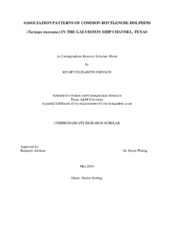| dc.creator | Johnson, Kelsey Elizabeth | |
| dc.date.accessioned | 2014-06-16T15:50:58Z | |
| dc.date.available | 2014-06-16T15:50:58Z | |
| dc.date.created | 2014-05 | |
| dc.date.issued | 2013-09-26 | |
| dc.date.submitted | May 2014 | |
| dc.identifier.uri | https://hdl.handle.net/1969.1/152042 | |
| dc.description.abstract | Dolphins in many parts of the world follow fishing boats to eat fish and invertebrates stirred into the water column by them, and so do the dolphins that frequent Galveston Bay and the Galveston Ship Channel. These individuals are frequently seen following shrimp trawling boats. The purpose of the study was to analyze occurrence patterns, site fidelity, and association patterns of bottlenose dolphins (T. truncatus) in the Galveston Ship Channel between September 2013 and March 2014. Patterns of dolphins not following shrimp trawlers were compared to those that follow the trawlers. Photo-identification was used to identify individual dolphins. The survey area was about 180,900 square meters of the western side of the ship channel, in front of the Texas A&M University at Galveston boat basin (29°18'45.84"N, and 94°49'1.42"W). Results show that while most individuals were seen only once, some dolphins returned regularly to the ship channel. More dolphins occurred in the fall and early winter months of the study, and the most common behavior was following after shrimper vessels. There were strong preferred associations between some individuals. The photographs taken in this study contribute to the Marine Mammal Behavioral Ecology Group database for long-term analysis. | en |
| dc.format.mimetype | application/pdf | |
| dc.subject | Dolphin, Galveston | en |
| dc.title | ASSOCIATION PATTERNS OF COMMON BOTTLENOSE DOLPHINS (Tursiops truncatus) IN THE GALVESTON SHIP CHANNEL, TEXAS | en |
| dc.type | Thesis | en |
| thesis.degree.department | Marine Biology | en |
| thesis.degree.discipline | Marine Biology | en |
| thesis.degree.grantor | Honors and Undergraduate Research | en |
| dc.contributor.committeeMember | Wursig, Bernd | |
| dc.type.material | text | en |
| dc.date.updated | 2014-06-16T15:50:58Z | |


